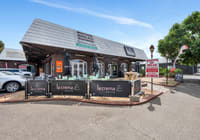
How does commercial property finance work
Article updated 2 September 2021.
When it comes to commercial property financing, the loan you apply for is going to be different than a standard residential mortgage, but exactly what sort of loan it is will really depend on what you’re buying.
Commercial property finance is typically lending for shops, office buildings or industrial assets such as warehouses and factories, to build and develop those properties in order to sell, or to purchase with the aim of renting them out, said Andrew Smith, Bendigo and Adelaide Bank.
“[It] can also consist of large residential land subdivisions or apartment construction that banks classify as falling under the commercial property finance category,” he said.
A commercial property loan requires security – otherwise known as collateral – which is necessary in case you default on your loan or, in a worst case, declare bankruptcy.
Collateral is typically in the form of another property, machinery or other large asset owned by your business.
However, the type of property used as collateral determines the level of risk.
For example, choosing to secure a commercial loan against a warehouse, or building, is deemed less of a risk than other assets such as childcare centres as they are easier to sell.
Commercial loans differ from residential lending in that they are typically more straightforward to apply for. This is due to the fact that residential lending is highly regulated.
Commercial finance varies depending on what you are purchasing or what the funds are being used for, as customers can secure “low-doc” or “no-doc” financing options.
Mortgage Choice Berwick commercial and residential lending specialist Alston Soff said another difference between residential loans and commercial lending was the size of the deposit needed.
“Be aware commercial property finance is a lot different to residential where you can buy a property with a 5 per cent deposit,” Mr Soff said.
“With commercial [loans] you need at least 30 per cent, so be aware with commercial property purchases [the deposit] is a lot higher.”
What are the types of commercial property loans?
Full-doc loan
This requires a complete assessment of the borrower and relevant applicants, or guarantors.
You will need to provide all income and liability statements such as financials, tax returns, credit card statements etc.
With such a product there is more work required upfront, however this option offers a more competitive rate to the customer.
Low-doc loan
No financial statements or tax returns are required.
The applicant and/or their accountant simply declares their total income and that they have the ability to meet their repayments.
This offers businesses with low profit margins greater options and flexibility and allows them to still obtain financing (typically a product only offered through the non-banks).
However, a low-doc loan comes with a higher interest rate because of the risk the lender takes with not completing a full assessment and thorough due diligence on income documents.
However, the application and approval process is usually quicker.
No-doc loan
There are no documents or accountant declarations needed for a no-doc loan.
This financing option is based on a strong exit strategy.
Turnaround for funding is much quicker but the interest rate is higher than that of low-doc or full-doc loans.
Equipment loans
Equipment finance products are designed to assist business customers to better manage their cash flow by providing access to funds to buy vehicles, plant, equipment and technology used to run a business, Mr Smith says, while they add value to the business by generating revenue and efficiency.
“Small to medium businesses use equipment finance to meet a significant part of their total funding needs. Unlike other forms of business loans, equipment finance facilities generally don’t require real estate to be pledged for the loan, with the asset being purchased providing the required collateral support,” he said.
Greater flexibility is a bonus of equipment finance as it allows investors to align repayment arrangements with their business’ cash flows and the asset’s lifespan.
Mr Soff said equipment loans on average ranged anywhere from five to seven years and were rarely any longer due to the fact that equipment depreciated quicker and the life of the asset was almost negligible.
According to Valiant Finance, most people take out equipment loans for three to seven years in duration, with five-year loans the most common.
The information provided in this article is intended to be of a general nature only and does not take into account any person’s particular objectives, financial situation or needs. You should always seek professional advice or assistance before making any financial decisions.










